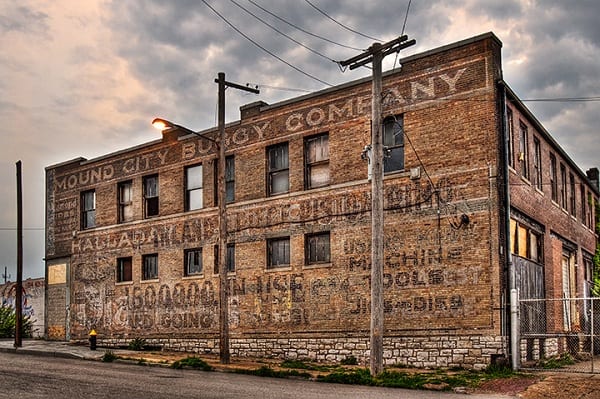3 Apr 2014
Fading Ads of St. Louis by Wm. Stage
This stunning photograph is from the cover of Wm. Stage‘s latest addition to the ghostsigns literature, ‘Fading Ads of St. Louis‘. Stage’s first book, ‘Ghost Signs‘, remains the definitive text on the topic and so it is no surprise to find his latest work full of fantastic photography and meticulous research. In this case Stage turns his attention to his home town of St. Louis, focusing on its rich heritage of painted wall signs and the stories behind the companies and men that led to their creation.
Stage was one of the first ghostsigns enthusiasts that I came across in my initial explorations of the topic. I quickly bought and reviewed his 1989 book and it remains a constant reference for me. Soon after I was in email correspondence with him from Cambodia, sharing stories of his own time in South East Asia and, of course, our mutual love of painted wall signs. This resulted in me writing a contribution to this latest book, an essay titled, ‘Ghost Signs: Their Place in History, on High Streets and in Our Hearts’. This represents a wider approach taken within the book to involve others, not least fellow photographers Ken Jones and Robert Frank (see cover image above).
Whereas his first book was a thorough coverage of the subject in general terms, this latest title goes much more deeply into the particular pieces of local history relating to each of the signs and the businesses they advertise(d). Chapters cover everything from general categories of products to specific brands such as Hyde Park Beer and Royal Patent Flour. Others include investigations into restoration projects, accounts of life in the field photographing ghostsigns, and an extended discussion of the debates and considerations surrounding efforts to protect and preserve signs, painted or otherwise. These latter chapters are, like the first book, more general in scope and build on ideas and debates first introduced in his earlier work.
For me, one of the highlights of the book is the lengthy ‘Walldogs‘ chapter at the end. This features extended interviews with two local veterans of the business, Jim Kargus and Lonnie Tettaton. These interviews give a fascinating insight into life up a ladder or, in one case, on a harness with a rope that’s about to snap. The interviews remind me of some of the accounts in the film Sign Painters and it is fantastic that Stage has added to this documentation of the craft’s history, in the words of those who practiced it.
In addition to the words of the Walldogs, Stage also provides a detailed account of the techniques used to produce painted wall signs. This includes material on layout, colour, types of paint and, of course, the benefits of white lead and its role in providing many of these signs with their longevity. It is this type of material in the book that makes it more than just a local historical volume, as with others that have been published in recent years. Stage is an expert on the topic at large and he has been able to weave this expertise into his book, while also providing a valuable local record of the signs in his home town. 24 years on, this is a great addition to not just Stage’s own work, but the wider body of published material on ghostsigns.
You can buy Fading Ads of St. Louise on Amazon (USA here) or direct from the publisher, the History Press. Find more books about ghostsigns and related topics in the shop and read more book reviews here on the Ghostsigns site.
Thank you to Wm. Stage for providing the photographs for this review, and to the History Press for providing the review copy of the book.








